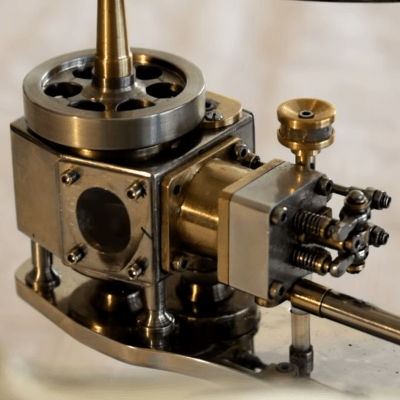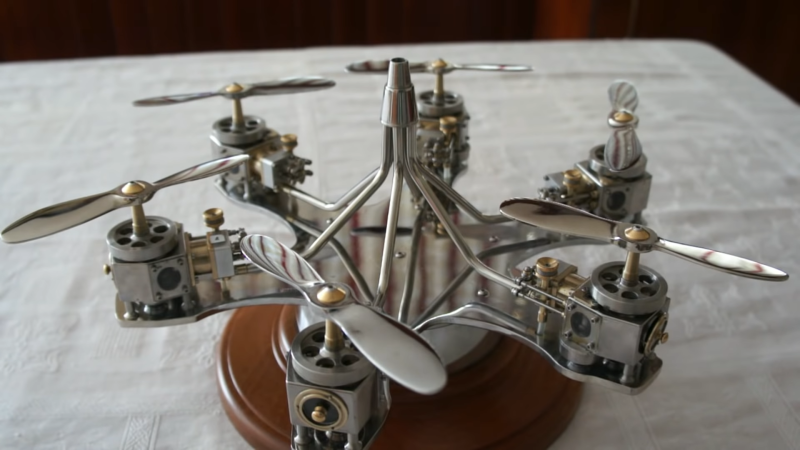From time to time it’s good to be reminded that mechanical engineering can also be art. [José Manuel Hermo Barreiro], also known as [Patelo], is a retired naval mechanic with a love for scale model engines. Using only basic tools and a lathe, he has built a non-flying hexacopter display model, each propeller turned by a tiny single cylinder motor that runs on compressed air. From the tiny components of the valve systems, the brass framed acrylic windows into the crankcases, and the persistence of vision disc on the exhaust, the attention to detail is breathtaking.

[Patelo] started the project on paper, and created a set of detailed hand-drawn blueprints to work from. Sadly a large part of the build took place during lockdown, and was not filmed, but we still get to see some work on a crankcase, connecting rod, camshaft, propellers, flywheel, and exhaust tubes. It is very clear that [Patelo] knows his way around his lathe very well, and is very creative with custom tools and jigs. The beautiful machine took approximately 1,560 hours to build, consists of 265 individually made parts held together with 362 screws.
We previously featured tiny V-12 engine that [Patelo] built around 2012. At that time he was 72 years of age, which means he should be around 80 now. We can only hope to come to emulate him one day, and that we get to see more of what comes out of his workshop. Hats off to you, sir.
















Cool. Subscribed to his channel.
I’d argue there’s art to many if not most mechanical design (and other disciplines)!
That is especially beautiful though.
“mechanical engineering can also be art.” Damn right for this thing!
Thats a beauty alright WOW
Breathless day-of reporting is not the HaD style. Come back in a week when the contents of the breach are better understood, until then you will mostly hear semiprofessional speculation.
Not “meant” to fly, but did he try like 3000 psi or so? Just curious :-D
There doesn’t seem to be any pitch to the propellers, so the only acceleration would be the outward fragmentation of the components as the blade tips exceeded Mach 1.
It’s not a very aggressive pitch, granted, but it does look like it has got a little to me. Advantage of small props though, is that you don’t have to worry about hitting mach at like 3-4k RPM like on your Cessna. They’d have to be over 50,000 RPM or so (Don’t know exact dimensions here)
Maybe someone will try it out on the moon base a few centuries from now. It seems to be built to last :)
That is a thing of non-functional art-for-arts-sake engineering beauty. Just wow. I have what can only be described as skill-envy.
Not to detract from the effort put forth by this craftsman for art’s sake, I was more fascinated years ago by this 12-year (20,000 hours) effort to build a working scale model of a Ferrari …
YouTube:
https://www.youtube.com/watch?v=vxYRa0pqxlw
More in-depth:
https://www.craftsmanshipmuseum.com/Scerri.htm
What drives those motors, where is the energy source?
The answer to this question is in the title of this article, and in the first paragraph. The power source is air, compressed air.
Thank you for your answer, I read title, but on that video is not visible from where that compressed air is coming from. That was the point of my question.
It appears there is a small translucent tube that Tee’s into the metal tube going to each motor. I assume that some air hits the engine and the rest is discharge out the tube to spin his tag. Possibly throttle the motors based on how much is lost.
Very nice hands on machining. I enjoy older engineering, no drawings needed, just a scribe and calipers.
At 14:57 you can see a small white line that comes up under each engine. Looks like the silver lines are for exhaust.